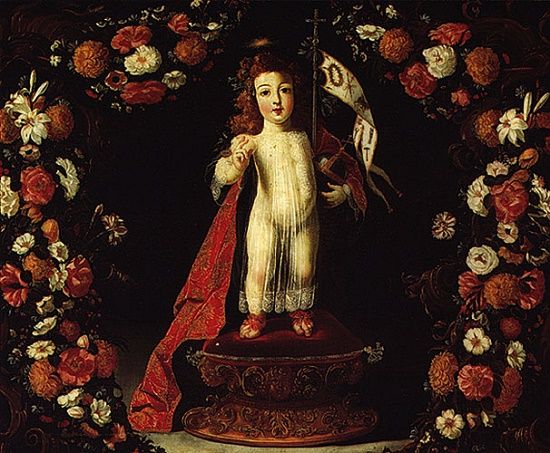Obras de referência da cultura portuguesa
"O MENINO JESUS SALVADOR DO MUNDO"
de JOSEFA D'ÓBIDOS
Igreja Matriz de Cascais
Análise de Rui-Mário Gonçalves
Tradução: Paul Bernard

Sob o ponto de vista estritamente técnico, quanto à execução e à acuidade visual, evidencia-se nesta pintura a minuciosa nitidez com que se representa o que é do domínio do tangível: as flores, o manto vermelho e as subtis transparências do vestido que envolve o corpo do menino. Já a representação deste, com o seu aspeto roliço e incerta colocação dos pés, é menos satisfatória, embora seja um dos mais aperfeiçoados de quantos foram representados por Josefa de Óbidos, nome com foi popularizada a pintora Josefa de Ayala e Cabrera (1630-1684), filha do grande mestre de naturezas-mortas Baltazar Gomes Figueira (1604-1674). Nascida em Sevilha, Josefa vem com o seu pai para Óbidos no ano 1633 ou 1634. Cerca de 1644, encontrava-se instalada no Mosteiro de Sant’Ana de Coimbra, recebendo aí ensinamentos religiosos enquanto aprendia a pintar com o seu pai.
Nessa época, a pintura de naturezas-mortas alcançava uma prática notável, em qualidade e quantidade, como nunca tivera anteriormente. Correspondia ao aparecimento da ciência experimental, que a partir de então foi passando a constituir cada vez mais o que podemos designar por “discurso da natureza”. Na época imediatamente anterior, ciência e arte não eram distinguíveis, o que levou, no estilo renascentista, a fazer com que, nas cenas representativas de temas religiosos, se obrigasse a respeitar as proporções naturais, a verdade anatómica, a perspetiva e outras leis da natureza. No século dezassete, a natureza-morta era o género que melhor servia este gosto do rigor na representação do mundo visível. A pintura podia optar por uma das duas atitudes seguintes: aproveitar o “discurso da natureza” dos cientistas para aperfeiçoar-se na imitação do visível, ou considerar que o “discurso da natureza” estava entregue aos cientistas, podendo portanto o artista voltar à não-ciência da representação de anjos e de milagres, como na Idade Média. Ora Josefa de Óbidos, como muitos outros pintores do seu tempo, realizou perfeitíssimas naturezas-mortas: umas, como puro e rigoroso apuramento da observação da natureza; outras, como serviço prestado à mística religiosa, conjugando a visão realista com o discurso simbólico. Convém não esquecer que no tempo do Barroco – e já no do Maneirismo – as pessoas praticavam habilmente os jogos de palavras e de conceitos, apreciando portanto as pinturas que misturassem os dois tipos de discurso, o realista e o simbolista. No quadro “O Menino Jesus Salvador do Mundo” pode observar-se o apelo aos dados dos sentidos: a vivacidade das cores, o encanto das formas e a alusão ao agradável perfume das flores simetricamente organizadas como uma grinalda, para ternamente festejar o Menino.
“CHILD JESUS SAVIOUR OF THE WORLD” by JOSEFA DE ÓBIDOS
Cascais Parish Church
From a strictly technical point of view, regarding its execution and visual acuity, this painting manifests the minute clarity with which that found in the dominion of the tangible is represented: the flowers, the red cape and the subtle transparencies of the clothing enveloping the child’s body. The representation of the latter, with its plumpness and unsure placement of the feet, is less satisfactory, although it is one of the most perfected examples of these represented by Josefa de Óbidos, the popular name for Josefa de Ayala e Cabrera (1630-1684), daughter of the grand master of still life Baltazar Gomes Figueira (1604-1674). Born in Seville, Josefa came to Óbidos with her father in 1633 or 1634. Around 1644, she was installed in the Sant’Ana Monastery of Coimbra where she received religious instruction whilst learning to paint like her father.
At the time, still life painting achieved notable practice, both in quality and quantity, as it never had previously. It corresponded to the appearance of experimental science that thenceforward began to increasingly constitute what we can designate as a “discourse on nature”. In the period immediately prior, science and art were indistinguishable, which led, in the Renaissance style and in scenes representing religious themes, to a respect for natural proportions, anatomical truth, perspective and other laws of nature. In the 17th c. still life was the genre that best served this rigour in representing the visible world. Painting could opt for one of the two following attitudes: take advantage of the “discourse on nature” of the scientists to perfect itself in the imitation of the visible, or consider that the “discourse on nature” was left to the scientists, the artist therefore being able to return to the non-science of representing angels and miracles as during the Middle Ages. Now Josefa de Óbidos, like many other painters of her day, undertook the most perfect still lifes; some as a pure and rigorous refinement of the observation of nature; others as a service to religious mysticism, combining the realist vision with the symbolic discourse. It should be remembered that during the Baroque era – and already in the Mannerist era – people ably practised games of words and concepts, and therefore appreciated paintings that mixed these two types of discourse, the realist and the symbolist. In the painting “Child Jesus Saviour of the World” one can observe the appeal of sensory data: the vivacity of the colours, the charm of the forms and the allusion to the pleasing perfume of the flowers symmetrically organised like a garland, tenderly celebrating the Child.
Obras de Referência da Cultura Portuguesa
projeto desenvolvido pelo Centro Nacional de Cultura
com o apoio do Ministério da Cultura


 Divulgue aqui os seus eventos
Divulgue aqui os seus eventos













